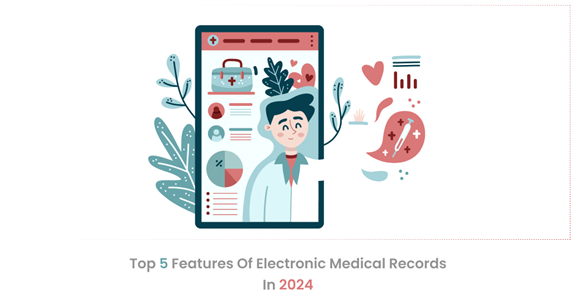Introduction
Over the past ten years, the healthcare business has seen a substantial transition, mostly as a result of technology improvements. In 2024, hospital administration and patient care will be redefined by EMR/EHR, which is leading this transformation. These systems have advanced from simple digital records to complex platforms with a wide range of features, greatly influencing hospital administration systems and enhancing patient outcomes. The top 5 aspects of the greatest software for electronic health records are examined in this article, along with how they improve electronic medical records in the healthcare industry.
Advanced Interoperability: The Backbone of Integrated Healthcare
The days of EMR/EHR systems functioning in isolation are a thing of the past. Advanced interoperability will be a requirement come 2024, not just a feature. Electronic health records have transformed patient care through seamless sharing and use of information across different settings within healthcare. This characteristic ensures that patients’ health information is accurate, up-to-date, and easily available regardless of whether they visit an ED, specialist, or primary care provider.
There are several merits associated with improved interoperability in electronic medical records. As such, it saves time and reduces costs by eliminating duplicative tests and procedures. More importantly, this narrows the margin for error while enhancing patient outcomes as it enables HCPs to make informed decisions quickly. The other function played by EHRs is simplifying administrative functions such as scheduling, billing, and compliance reporting within hospital management systems which leads to enhanced operational efficiency.
AI-Driven Predictive Analytics: A Leap Towards Proactive Care
A huge advancement in healthcare technology is the incorporation of artificial intelligence into electronic health records. Predictive analytics powered by AI can sort through enormous volumes of data to find trends, forecast results, and recommend preventive actions. This capacity is extremely helpful in the management of chronic illnesses since early intervention can dramatically change the course of the disease and enhance the quality of life.
Additionally, by projecting patient admissions and discharges, predictive analytics helps improve staff scheduling and resource allocation in the Hospital management system. Showcasing the many advantages of electronic medical records, the finest EHR software makes use of this technology to enhance patient care as well as boost operational efficiency in the healthcare industry.
Telehealth Integration: Bridging the Gap Between Patients and Care
Telehealth is one of the largest leaps in healthcare and its growing importance has been facilitated greatly by the use of EMR/EHR systems. Virtual care services are not replacements but rather additions to traditional healthcare since internet based electronic medical records have telehealth features. This integration provides a continuum of care and virtual consultations because it gives real-time access to the patient’s test results, prescription lists, and medical history.
This increases the convenience of health services as well as their availability for patients; moreover, such tools could be used in managing public health emergencies like pandemics where contact should be reduced. As far as e-records are concerned in healthcare, they prove to be very flexible and adjustable thereby allowing for remote treatment which means that more people can receive high-quality care.
Enhanced Data Security and Privacy: Safeguarding Patient Information
As electronic medical record systems proliferate, data security and privacy could not be overemphasized. To safeguard private patient data, the latest electronic health records software of 2024 incorporates modern security features. By using encryption, multi-factor authentication and continuous monitoring as common features to prevent unauthorized accesses and breaches to information.
These advancements in data security are critical in maintaining patient trust, a cornerstone of electronic medical records in healthcare. These developments have highlighted the benefits of electronic medical records in the digital era by ensuring that health care providers fulfill their ethical responsibility to preserve patient confidentiality even as they exploit technology to improve care.
Patient Engagement Tools: Empowering Patients in Their Care Journey
Turning electronic medical record systems into patient interaction platforms is a major step closer to a more patient-centered care. These include integrated patients’ portals that enable individuals to manage their treatment, view their own medical information, and communicate with doctors. Openness and personal touch have been the driving forces behind patients actively participating in their healthcare that nurtures collaborative connection between them and their physicians.
However, there are broader effects of these tools on individual patient involvement. By encouraging preventive care behaviors, improving treatment regimen adherence, and facilitating improved disease management, they could contribute toward better public health outcomes. Thus, online electronic medical records access and patient interaction options represent the first critical stage towards building more knowledgeable, engaged and healthier populations.
Conclusion
To be sure, the electronic medical record system of 2024 is a testimony to how far healthcare technology has advanced. The patient engagement tools, telehealth integration, AI-driven predictive analytics, enhanced data security and the advanced interoperability are among the features of the best electronic health records software that have revolutionized healthcare delivery and management. They do not just transform patients’ documents into digital files. These systems are necessary for delivering excellent care, improving patient outcomes, and optimizing operations in health care organizations. This will certainly be dependent on which companies come out with the best EHR software as it would determine how EMRs are used in healthcare moving forward while grappling with providing care in an era of digitalization.
